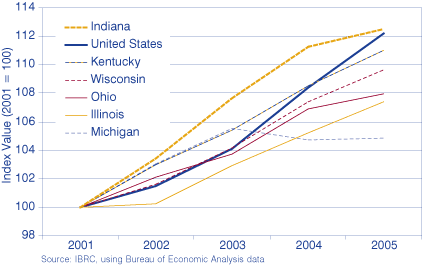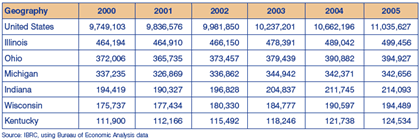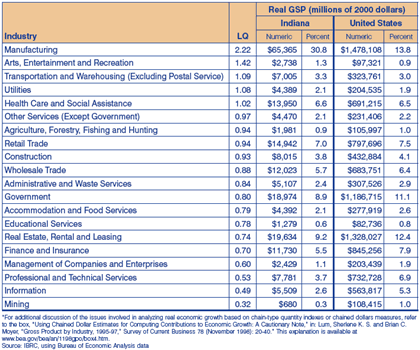Indiana's Economy Still Growing, but More Slowly
Many observers were encouraged by recent reports that the U.S. economy grew at an annual rate of 3.5 percent in 2005, though the national growth rate was down somewhat from the prior year's 4.2 percent. The growth rate of Indiana's economy, however, while still positive, slowed to 46th in the nation, according to new figures released by the Bureau of Economic Analysis (BEA).
These conclusions are based on preliminary estimates of gross state product (GSP), the most comprehensive measure of a state's overall economic activity. The BEA produces estimates each year for total state GSP, followed some months later by estimated breakouts of GSP by industry.
Indiana's real GSP in 2005 was estimated at $214.1 billion, up 1.1 percent from 2004 (expressed in 2000 dollars to account for inflation). This modest growth allowed Maryland (which grew by 3.7 percent) to surpass Indiana to claim the 15th largest economy in the nation, with the Hoosier state dropping to 16th.
Overall, the Great Lakes region was the slowest-growing part of the nation in 2005, averaging only 1.3 percent GSP growth over 2004. Table 1 shows real GSP for Indiana and nearby states as well as the United States from 2000 through 2005, and Figure 1 indicates the percentage by which these figures changed each year. Several Midwestern manufacturing states, including Indiana, were seriously rocked by the recession and experienced negative economic growth in 2001. All of these states' economies have grown somewhat in subsequent years (except for Michigan in 2004), even though the growth rates varied significantly across the states. Indiana's growth rate led the region in 2002 through 2004, but its growth fell behind Kentucky, Illinois and Wisconsin in 2005.
Table 1: Total Real GSP (Millions of 2000 Dollars), Midwestern States, 2000 to 2005
Figure 1: Annual Change in Real Gross State Product, 2001 to 2005

Figure 2 puts the cumulative effects of these changes into perspective, depicting the cumulative change in GSP since 2001 for Indiana relative to nearby states and the United States. The values in this chart are indexed to a base of 100 representing each state's starting value in 2001. Indiana leads the pack with a 2005 index of 112.5, which means that its economy has grown by 12.5 percent since 2001, slightly ahead of the national economy's growth during the same period.
Figure 2: Relative Change in Total GSP, 2001 to 2005

Some Hoosier observers may be concerned with the slowing pace of Indiana's economic growth. Unfortunately, it's difficult at present to diagnose the contributing factors because industry-level GSP data for 2005 are not yet available from the BEA. A breakout of contributions to Indiana's economy by industry for 2004 is shown in Table 2, which shows dollar value of output from each major industry group and the corresponding percentage of total GSP for both Indiana and the nation. The table also shows the location quotient (LQ) for each industry based on the GSP data. These location quotients indicate the contribution of each industry to the state's economy expressed relative to the national average. Thus, for example, the LQ of 2.22 for manufacturing indicates that the manufacturing sector accounts for 2.22 times as high a percentage of Indiana's economy as the sector's percentage of the U.S. economy.
Table 2: Contributions to GSP by Industry in Indiana and the United States, 2004
Manufacturing is by far the largest contributor to Indiana's economy, accounting for more than 30 percent of the state total. It may be that stress in this sector, which continues to experience substantial workforce shrinkage nationally, increased its impact on Indiana in 2005. However, the data to address this issue will not be available for several more months. In the interim, GSP figures for prior years lean in this direction, as the growth rate of Indiana manufacturing output shrank from 12.1 percent in 2002 to 6.4 percent in 2003 and 4.6 percent in 2004. Thus, the sector appears to be contributing less over time to the state's overall economic growth. When new 2005 data are released showing industry details, we will follow up on this issue.
Jerry Conover, Director
Indiana Business Research Center, Kelley
School of Business, Indiana University


